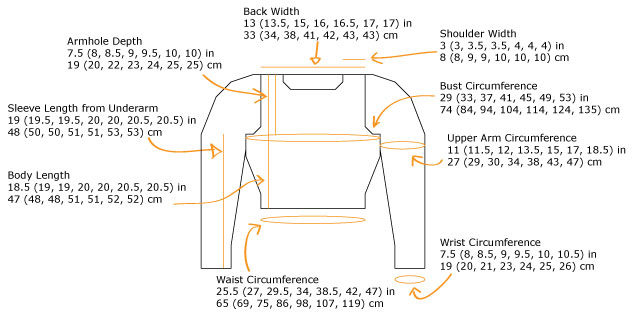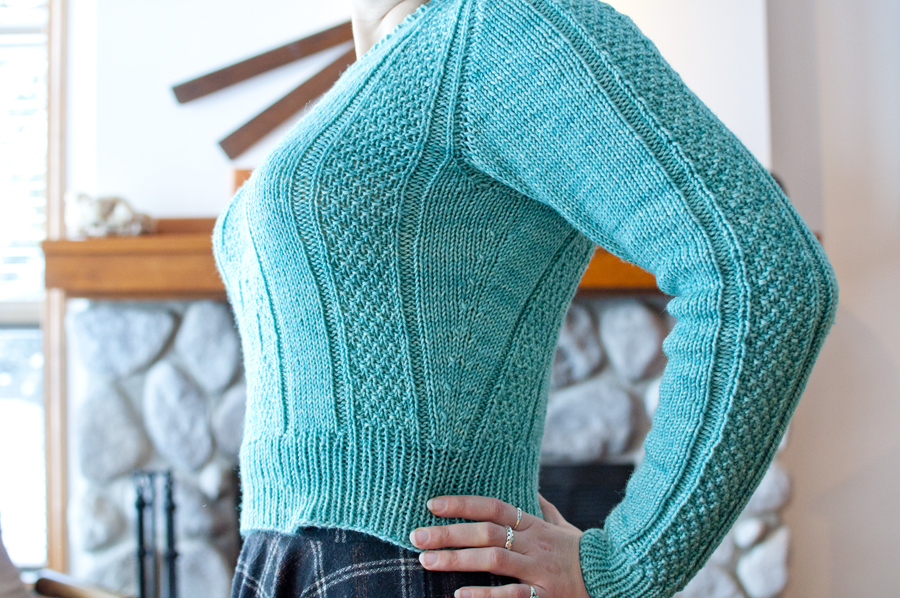
One of the most frequent questions I get about patterns isn’t about confusing instructions or a specific request for help. The question is, “Are you sure this is right?” Often it will include some variation on, “Am I really supposed to knit this many rows? The larger sizes don’t have as many.” Or the smaller sizes have more! Or it’s about stitch counts.
I tend to think of these as keep-your-eyes-on-your-own-page problems. The question wouldn’t come up if the knitter only could see their own size, but I get why people might doubt the correctness. There’s an understandable desire to simplify things. Larger sizes should have larger stitch and row counts, and smaller sizes should have smaller stitch and row counts, right? Well, not entirely. This might be true of the full sweater as a whole, but it doesn’t break down like that when you’re looking at only a small section of that same sweater. Human bodies don’t increase in size in equal proportions across the board. For example, larger arms generally need larger armholes to move comfortably, but larger bodies don’t have dramatically longer waists than smaller bodies, so the armhole to waist measurement is frequently longer on smaller sizes than larger sizes, even though the full sweater length might be shorter overall for the smaller sizes, or equal in length.
Beyond fit, there are distribution differences that make a pattern easier to follow but may look odd, like working an even increase rate for all increases or decreases for a section of a single size with a straight section before or after to hit length goals, rather than a variable increase or decrease rate. Because of the flexibility of knitting, it will still fit well, and the knitter doesn’t have to worry about using multiple rates for their shaping. For example, the straight section on a sleeve prior to decreases might be shorter for larger sizes that have more increases worked, which can leaves a smaller remainder when using a consistent shaping rate due to having smaller more frequent increments, but the fit isn’t negatively affected because they need more rapid shaping overall.
Not getting stuck on these differences isn’t always easy if you don’t fully trust the pattern and/or are unfamiliar with the complexities of grading for a range of sizes and pattern writing. It’s perfectly understandable!

I’m not going to tell you to keep your eyes on your own size or to blindly trust the pattern. You can double check the numbers for yourself! Add up the rows or stitches for the full section so you get the big picture, divide by gauge, and compare to the schematic. If the pattern is accurate, the measurements will match, give or take a little for rounding. The pattern section names won’t always perfectly match the schematic labels, but you should have enough information to figure it out. You may have to look at things from a bigger picture view than you did initially, but that’s okay! This question generally comes up from focusing in on small details without seeing how they work in the larger scheme of things.
Last but not least, this post is the encourage you to be more confident about your knitting, not to discourage you from emailing me about possible errors. Everyone who works on Untangling Knots patterns is human, so the occasional error does happen. This is simply to help you check that it isn’t confusion about how grading and ease of use affect the numbers. Checking the numbers for yourself will always be faster than emailing me, so you can get back to your knitting more quickly.

Leave a Reply